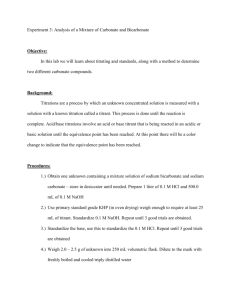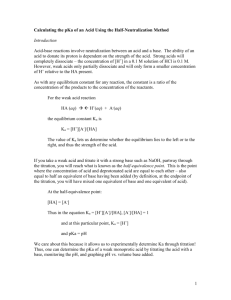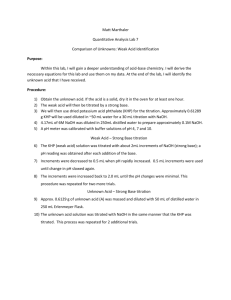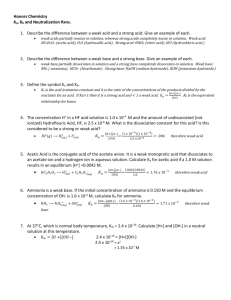Station 1 – LT 6.1 Lesson 6.1 – Acid/Base Properties Questions 1
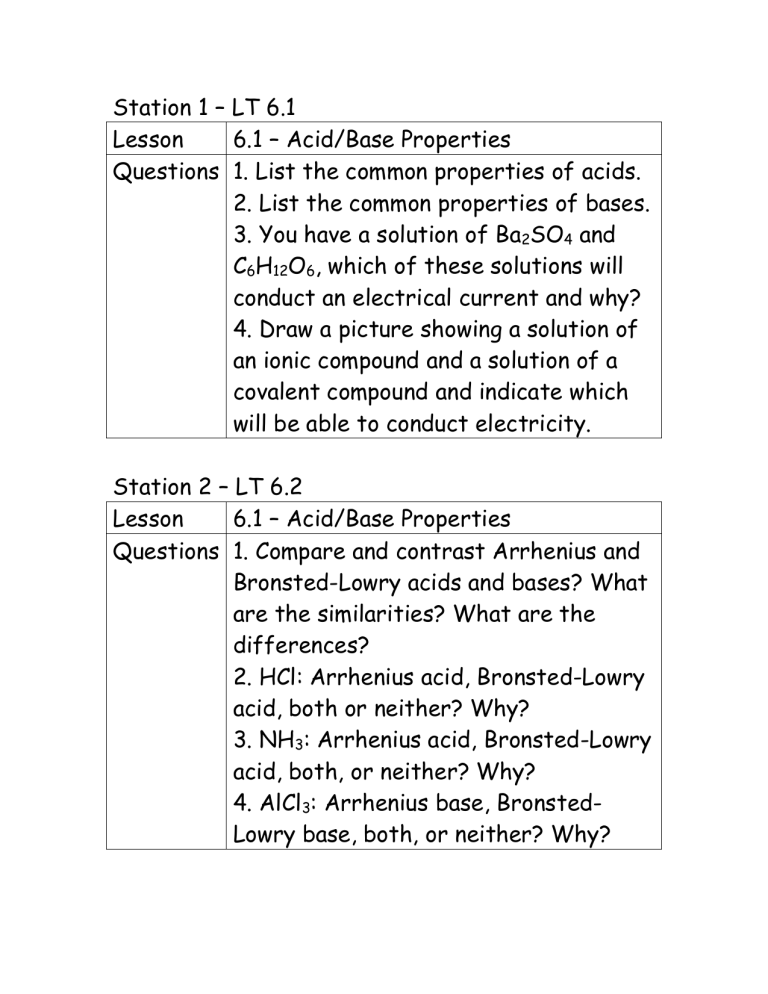
Station 1 – LT 6.1
Lesson 6.1 – Acid/Base Properties
Questions 1. List the common properties of acids.
2. List the common properties of bases.
3. You have a solution of Ba
2
SO
4
and
C
6
H
12
O
6
, which of these solutions will conduct an electrical current and why?
4. Draw a picture showing a solution of an ionic compound and a solution of a covalent compound and indicate which will be able to conduct electricity.
Station 2 – LT 6.2
Lesson 6.1 – Acid/Base Properties
Questions 1. Compare and contrast Arrhenius and
Bronsted-Lowry acids and bases? What are the similarities? What are the differences?
2. HCl: Arrhenius acid, Bronsted-Lowry acid, both or neither? Why?
3. NH
3
: Arrhenius acid, Bronsted-Lowry acid, both, or neither? Why?
4. AlCl
3
: Arrhenius base, Bronsted-
Lowry base, both, or neither? Why?
Station 3 – LT 6.3
Lesson 6.1 – Acid/Base Properties
Questions 1. What is the difference between a strong acid and a weak acid?
2. List the seven strong acids.
3. List the seven strong bases.
4. If we say something is completely dissociated, what does that mean?
Station 4 – LT 6.4
Lesson 6.2 – Logarithms and pH
Questions 1. What is the pH scale? Why do scientists use this scale?
2. Classifying the following as acidic, basic, or neutral. a. Pure water b. pH of 2 c. pH of 10 d. Tastes sour e. Common household cleaners f. pH of 7.2 g. Turns phenolphthalein (from the titration lab) pink.
3. What is the pH of a solution measuring?
Station 5 – Calculating logs
Lesson 6.2 – Logarithms and pH
Questions 1. log
3
x = 9
2. log
2
8 = x
3. log
3
27 = x
4. log
3
x = 4
5. log y = 2
6. log 1000 = x
Station 6 – LT 6.5
Lesson 6.3 – Logarithms and pH
Questions 1. Determine the pH of a 0.0001 M
HNO
3
solution.
2. Determine the pOH of a 0.000001 M
NaOH solution.
3. Determine the pH of a 0.01 M NaOH solution.
4. Determine the pH of a 0.005 M
NaOH solution.
Station 7 – LT 6.6
Lesson 6.3 – Titrations
Questions 1. What is the equivalence point and how is it used in a titration?
2. What is an indicator and why does it help with identifying the equivalence point?
3. If it takes 54 mL of 0.1 M NaOH to neutralize 125 mL of an HCl solution, what is the concentration of the HCl?
4. If it takes 50 mL of 0.5 M KOH solution to completely neutralize 125 mL of sulfuric acid solution (H
2
SO
4
), what is the concentration of the H
2
SO
4 solution?
Station 8 – LT 6.6
Lesson 6.3 – Titrations
Questions 1. Why did you have to make sure that you stopped titrating when a faint pink color appeared? What would happen if you titrated through this faint pink color?
2. If it takes 25 mL of 0.05 M HCl to neutralize 345 mL of NaOH solution, what is the concentration of the NaOH solution?
3. Draw a titration curve and indicate the equivalence point on your graph.
4. In a titration experiment, 25.00 mL of
H
2
SO
4
solution is dispensed into a flask and titrated using a 0.2148 M NaOH solution. The student add 34.16 mL of
NaOH solution, at which point the solution is bright pink due to phenolphthalein indicator. In order to correct this the error, the student adds 6.14 mL of 0.1427
M solution of HNO
3
, after which a perfect endpoint is achieved. Given the information, what is the concentration of the original H
2
SO
4
solution.
Station 9 – LT 6.7
Lesson 6.4 – Lewis Acids and Bases
Questions 1. What is an Arrhenius acid/base?
What is a Bronsted-Lowry acid/base?
How are these different?
2. What is a Lewis acid/base?
3. How can something be considered a
Bronsted-Lowry acid, but not an
Arrhenius acid? Give an example of this.
4. Identify each acid and base in the reactions and classify as Arrhenius,
Bronsted-Lowry, and/or Lewis: a. H
2
SO
4
+ Ca(OH)
2
H
2 b. H
3
PO
4
+ NH
3
H
2
PO
O + Ca(HSO
4
4
- + NH
4
+
)
2 c. AlCl
3
+ Cl AlCl
4
-
Station 10 – LT 6.8
Lesson 6.4 – Lewis Acids and Bases
6.5 – Buffers
Questions 1. Identify the acid, base, conjugate acid, and conjugate base in the following reaction:
CH
3
COOH + H
2
O CH
3
COO + H
3
O +
2. Why is a buffer able to resist the change in the solutions pH? Why does this not happen with a strong acid/base?
3. Draw the titration curve for a weak acid titrated with a strong base.
Indicate the area where it has buffering capacity.



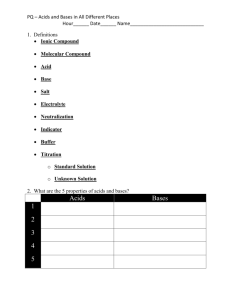

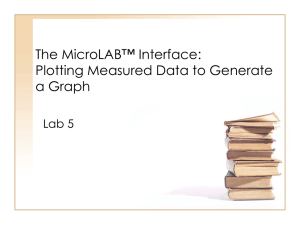
![pH = - log [H + ]](http://s2.studylib.net/store/data/005622524_1-002df1ea50d2a849b15deb604928664e-300x300.png)

